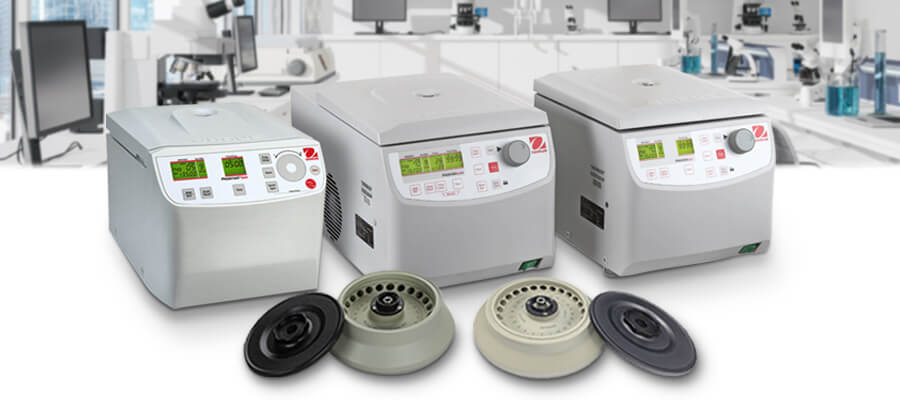
“It's science.” This phrase is often used as a punchline, but buried inside the joke is the acknowledgement that research, development, experimentation, and measurement - the very components of “science” - cannot happen without rigorous processes and finely-tuned instruments. When selecting lab equipment, it is important to understand how every piece functions, and what they can mean for both data collection and workplace safety - no joking around.
In the case of equipment such as OHAUS' Frontier Series Micro Centrifuges (Models
FC5515,
FC5515R, and
FC5513), everything from their compact design to—most importantly—durable and reliable rotors play key roles. When you have rotors designed to safely accommodate spin columns it eliminates the tedious work of trying to position the tubes in a certain way to prevent the centrifuge tube caps from breaking off. This not only saves time and sample compromise, but it also provides for much safer centrifugation.
But let's back up. Integral in DNA and RNA extraction, a Centrifuge is a powerful laboratory instrument that uses centrifugal force, created by spinning a container at high speed around a fixed axis, to separate components based on their density, size and shape. Centrifuges are used in a variety of scientific and medical fields, including molecular biology, biochemistry, chemistry and clinical diagnostics. The speed and power required depends upon the specific application. The best centrifuges are adaptable for various needs and designed for the safety of the user and the laboratory environment.
How are Centrifuges used in DNA and RNA extraction?
Centrifuges play a critical role in DNA and RNA extraction, specifically they are used for the separation and purification of nucleic acids. The first step of the DNA and RNA extraction process involves cell lysis, which breaks open the cell to release the nucleic acids. After cells are lysed, the mixture is placed inside a centrifuge. Centrifugal force separates the nucleic acids from other cellular components such as proteins and lipids. After separation, the nucleic acids are typically precipitated out of the solution using alcohol, which causes the DNA or RNA to clump together and become visible. Finally, the DNA/RNA is washed and purified to remove any remaining contaminants. Sometimes spin columns are used to further purify the nucleic acids.
What are some common safety concerns with Centrifuges?
Considering the power and speed of centrifuges, common safety concerns include:
● Mechanical Hazards: Centrifugal force can cause the rotor or centrifuge tube to break or rupture. For example, if a spin column is placed into a spin column rotor that isn’t designed to handle it, its flip cap can snap off (which can damage the unit and the sample)
● Chemical Hazards: Precautions for handling and disposal must be taken especially when you are working with hazardous chemicals, in order to avoid exposure or damage to the centrifuge. Just as in the above example, cracking of the spin columns themselves can lead to potentially dangerous leakages.
● Biological Hazards: When handling biological materials that carry a risk of infection, you need to ensure all components are in proper alignment, and that personal protective equipment (PPE) is worn. OHAUS’ Micro Centrifuges offer biosealed rotors designed specifically to contain potentially hazardous aerosols.
● Imbalance Hazards: An imbalanced or improperly secured sample can throw off a rotor and potentially damage the device, especially after constant use.
The OHAUS Frontier series features automatic imbalance sensors, which stop the device immediately if irregularities are detected.
Any one of these hazards can have damaging effects, from serious personal injury to simply loss of samples (and time). Reliability and consistency—in a word "trust"—in your devices is a necessity.
What components are essential within a Centrifuge?
Rotors
The rotor attaches to the spindle or axis of the centrifuge and connects to its motor. Designed to safely hold and secure sample tubes, rotors must be constructed out of highly durable materials like high strength plastics or metal that are built to withstand speed and force. Rotors are an important feature in selecting a centrifuge as they play an essential role in the separation of substances, and they provide a secure balanced platform to hold samples. There are various types of rotors available, including fixed-angle rotors, swinging-bucket rotors, vertical rotors each suited for specific centrifugation needs.
Spin Columns
After preparation, the sample is then put in what is called a spin column. Spin columns typically contain a stationary matrix, which helps selectively bind target biomolecules while allowing others to pass through. The spin column is then placed within the spin column rotor and centrifuged—which forces the solution through the matrix, allowing it to separate. The target molecule is then eluted from the spin column and collected in a clean centrifuge tube.
Rotor Angle 24 x 2.0 ml Spin Column
Compatible with:
Rotor Angle 24 x 2.0 ml Spin Column V1 Compatible with:
As mentioned, a concern with some spin columns is the tendency for the caps to crack or loosen due to the rotos not being specifically designed to handle spin columns (or simply from frequent use). With their newly redesigned spin column rotors, the OHAUS Frontier Centrifuges (Models
FC5515,
FC5515R, and
FC5513) are built to house spin columns properly, such as those manufactured by Pall or Qiagen. When coupled with its user-friendly interface (the controls are responsive, even when the user is wearing rubber gloves), these Centrifuges provide top tier safety without sacrificing speed or efficiency.
There is no such thing as a minute detail when it comes to lab work or laboratory equipment. Every piece plays a vital role in keeping samples and users safe. It's science.
For more information about OHAUS Spin Column Rotors,
contact your OHAUS account manager.